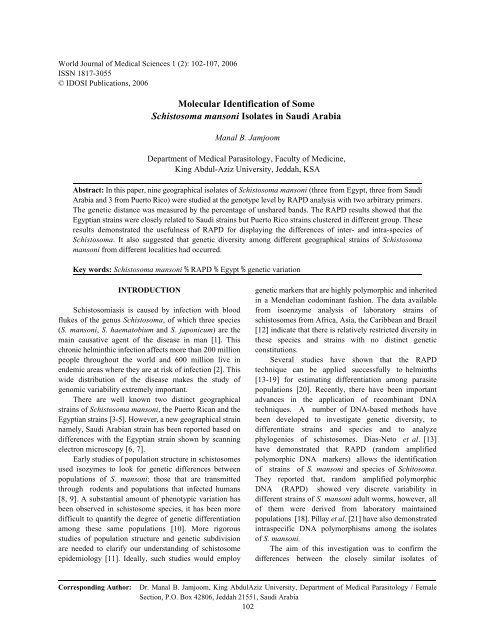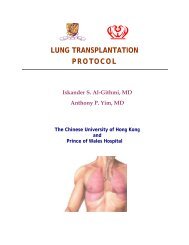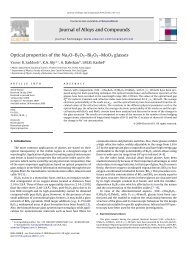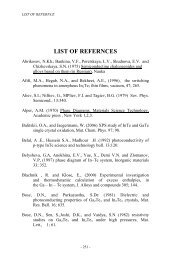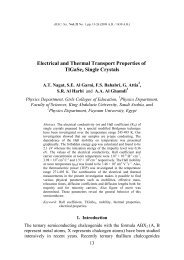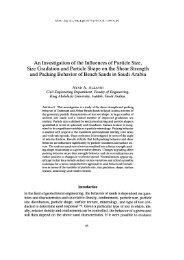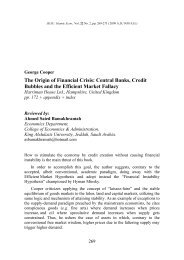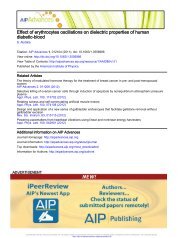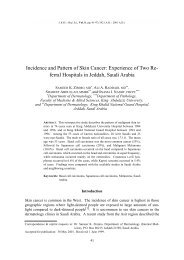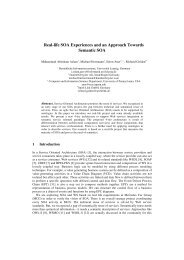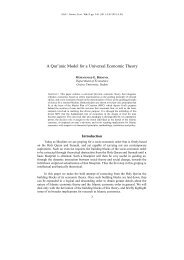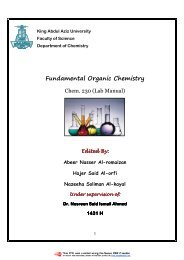Molecular identification of some Schistosoma mansoni isolates in Sa
Molecular identification of some Schistosoma mansoni isolates in Sa
Molecular identification of some Schistosoma mansoni isolates in Sa
You also want an ePaper? Increase the reach of your titles
YUMPU automatically turns print PDFs into web optimized ePapers that Google loves.
World Journal <strong>of</strong> Medical Sciences 1 (2): 102-107, 2006<br />
ISSN 1817-3055<br />
© IDOSI Publications, 2006<br />
<strong>Molecular</strong> Identification <strong>of</strong> Some<br />
<strong>Schistosoma</strong> <strong>mansoni</strong> Isolates <strong>in</strong> <strong>Sa</strong>udi Arabia<br />
Manal B. Jamjoom<br />
Department <strong>of</strong> Medical Parasitology, Faculty <strong>of</strong> Medic<strong>in</strong>e,<br />
K<strong>in</strong>g Abdul-Aziz University, Jeddah, KSA<br />
Abstract: In this paper, n<strong>in</strong>e geographical <strong>isolates</strong> <strong>of</strong> <strong>Schistosoma</strong> <strong>mansoni</strong> (three from Egypt, three from <strong>Sa</strong>udi<br />
Arabia and 3 from Puerto Rico) were studied at the genotype level by RAPD analysis with two arbitrary primers.<br />
The genetic distance was measured by the percentage <strong>of</strong> unshared bands. The RAPD results showed that the<br />
Egyptian stra<strong>in</strong>s were closely related to <strong>Sa</strong>udi stra<strong>in</strong>s but Puerto Rico stra<strong>in</strong>s clustered <strong>in</strong> different group. These<br />
results demonstrated the usefulness <strong>of</strong> RAPD for display<strong>in</strong>g the differences <strong>of</strong> <strong>in</strong>ter- and <strong>in</strong>tra-species <strong>of</strong><br />
<strong>Schistosoma</strong>. It also suggested that genetic diversity among different geographical stra<strong>in</strong>s <strong>of</strong> <strong>Schistosoma</strong><br />
<strong>mansoni</strong> from different localities had occurred.<br />
Key words: <strong>Schistosoma</strong> <strong>mansoni</strong> % RAPD % Egypt % genetic variation<br />
INTRODUCTION<br />
genetic markers that are highly polymorphic and <strong>in</strong>herited<br />
<strong>in</strong> a Mendelian codom<strong>in</strong>ant fashion. The data available<br />
Schistosomiasis is caused by <strong>in</strong>fection with blood from isoenzyme analysis <strong>of</strong> laboratory stra<strong>in</strong>s <strong>of</strong><br />
flukes <strong>of</strong> the genus <strong>Schistosoma</strong>, <strong>of</strong> which three species schisto<strong>some</strong>s from Africa, Asia, the Caribbean and Brazil<br />
(S. <strong>mansoni</strong>, S. haematobium and S. japonicum) are the [12] <strong>in</strong>dicate that there is relatively restricted diversity <strong>in</strong><br />
ma<strong>in</strong> causative agent <strong>of</strong> the disease <strong>in</strong> man [1]. This these species and stra<strong>in</strong>s with no dist<strong>in</strong>ct genetic<br />
chronic helm<strong>in</strong>thic <strong>in</strong>fection affects more than 200 million constitutions.<br />
people throughout the world and 600 million live <strong>in</strong> Several studies have shown that the RAPD<br />
endemic areas where they are at risk <strong>of</strong> <strong>in</strong>fection [2]. This technique can be applied successfully to helm<strong>in</strong>ths<br />
wide distribution <strong>of</strong> the disease makes the study <strong>of</strong> [13-19] for estimat<strong>in</strong>g differentiation among parasite<br />
genomic variability extremely important.<br />
populations [20]. Recently, there have been important<br />
There are well known two dist<strong>in</strong>ct geographical advances <strong>in</strong> the application <strong>of</strong> recomb<strong>in</strong>ant DNA<br />
stra<strong>in</strong>s <strong>of</strong> <strong>Schistosoma</strong> <strong>mansoni</strong>, the Puerto Rican and the techniques. A number <strong>of</strong> DNA-based methods have<br />
Egyptian stra<strong>in</strong>s [3-5]. However, a new geographical stra<strong>in</strong> been developed to <strong>in</strong>vestigate genetic diversity, to<br />
namely, <strong>Sa</strong>udi Arabian stra<strong>in</strong> has been reported based on differentiate stra<strong>in</strong>s and species and to analyze<br />
differences with the Egyptian stra<strong>in</strong> shown by scann<strong>in</strong>g phylogenies <strong>of</strong> schisto<strong>some</strong>s. Dias-Neto et al. [13]<br />
electron microscopy [6, 7].<br />
have demonstrated that RAPD (random amplified<br />
Early studies <strong>of</strong> population structure <strong>in</strong> schisto<strong>some</strong>s polymorphic DNA markers) allows the <strong>identification</strong><br />
used isozymes to look for genetic differences between <strong>of</strong> stra<strong>in</strong>s <strong>of</strong> S. <strong>mansoni</strong> and species <strong>of</strong> Schitosoma.<br />
populations <strong>of</strong> S. <strong>mansoni</strong>: those that are transmitted They reported that, random amplified polymorphic<br />
through rodents and populations that <strong>in</strong>fected humans DNA (RAPD) showed very discrete variability <strong>in</strong><br />
[8, 9]. A substantial amount <strong>of</strong> phenotypic variation has different stra<strong>in</strong>s <strong>of</strong> S. <strong>mansoni</strong> adult worms, however, all<br />
been observed <strong>in</strong> schisto<strong>some</strong> species, it has been more <strong>of</strong> them were derived from laboratory ma<strong>in</strong>ta<strong>in</strong>ed<br />
difficult to quantify the degree <strong>of</strong> genetic differentiation populations [18]. Pillay et al. [21] have also demonstrated<br />
among these same populations [10]. More rigorous <strong>in</strong>traspecific DNA polymorphisms among the <strong>isolates</strong><br />
studies <strong>of</strong> population structure and genetic subdivision <strong>of</strong> S. <strong>mansoni</strong>.<br />
are needed to clarify our understand<strong>in</strong>g <strong>of</strong> schisto<strong>some</strong> The aim <strong>of</strong> this <strong>in</strong>vestigation was to confirm the<br />
epidemiology [11]. Ideally, such studies would employ differences between the closely similar <strong>isolates</strong> <strong>of</strong><br />
Correspond<strong>in</strong>g Author:<br />
Dr. Manal B. Jamjoom, K<strong>in</strong>g AbdulAziz University, Department <strong>of</strong> Medical Parasitology / Female<br />
Section, P.O. Box 42806, Jeddah 21551, <strong>Sa</strong>udi Arabia<br />
102
World J. Med. Sci., 1 (2): 102-107, 2006<br />
Schitosoma <strong>mansoni</strong> isolated from different localities<br />
RESULTS AND DISCUSSION<br />
(<strong>Sa</strong>udi Arabia, Egypt and Puerto Rico) <strong>in</strong> which the<br />
morphological and physiological characters were not N<strong>in</strong>e <strong>isolates</strong> <strong>of</strong> S. <strong>mansoni</strong> were used <strong>in</strong> this<br />
enough for obvious separation.<br />
study. The two primers (5'-GAAACAAATG-3' and 5'-<br />
GTGACGTAGG-3') used <strong>in</strong> this study, generated a<br />
MATERIALS AND METHODS<br />
considerable number <strong>of</strong> amplification products for<br />
comparison. A different DNA band<strong>in</strong>g pattern was<br />
Parasite <strong>isolates</strong>: N<strong>in</strong>e <strong>isolates</strong> <strong>of</strong> repeated twice S. present <strong>in</strong> almost every <strong>isolates</strong>. Comparison <strong>of</strong> each<br />
<strong>mansoni</strong> were obta<strong>in</strong>ed from different places: SMS1,2,3 pr<strong>of</strong>ile for each <strong>of</strong> the primers was based on the presence<br />
(from <strong>Sa</strong>udi Arabia); SME1,2,3 (from Egypt) and SMP1,2,3 (1) versus absence (0) <strong>of</strong> RAPD amplimers that migrated<br />
(from Puerto Rico).<br />
to the same position <strong>in</strong> the gel. Bands <strong>of</strong> the same size<br />
obta<strong>in</strong>ed by the same primer were scored as identical,<br />
Isolation <strong>of</strong> genomic DNA: DNA was extracted from but only bands repeatable <strong>in</strong> at least two experiments<br />
<strong>in</strong>dividual adult worms as follows: frozen worms were with the same primer at different times were evaluated. All<br />
<strong>in</strong>dividually homogenized with a pestle <strong>in</strong> 100 µL <strong>of</strong> 10 mm two primers revealed high similarities between each<br />
Tris-HCl pH8; 1mm EDTA, 10 mm NaCl and 70 mm sucrose type <strong>of</strong> <strong>isolates</strong> (Figs. 1 & 2). Anou et al. [28] reported<br />
(extraction buffer). The pestle was r<strong>in</strong>sed <strong>in</strong> an Eppendorf that <strong>isolates</strong> <strong>of</strong> <strong>Schistosoma</strong> japonicum showed identical<br />
tube with 10% sodium dodecyl sulphate and 12 µL <strong>of</strong> RAPD patterns by us<strong>in</strong>g seven primers.<br />
1<br />
prote<strong>in</strong>ase (10 mg mLG ). The homogenate was <strong>in</strong>cubated The comb<strong>in</strong>ed data from all <strong>isolates</strong> <strong>of</strong> S. <strong>mansoni</strong><br />
at 57°C for 2 h, then extracted once with an equal volume by us<strong>in</strong>g two different primers were analyzed to<br />
<strong>of</strong> phenol and once with chlor<strong>of</strong>orm. The solution was produce a dendrogram (Fig. 3). Accord<strong>in</strong>g to dendrogram<br />
adjusted to 03 m with sodium acetate and precipitated at constructed from RAPD data, the <strong>isolates</strong> <strong>of</strong> <strong>Schistosoma</strong><br />
20°C overnight with 2 volumes <strong>of</strong> absolute ethanol. <strong>mansoni</strong> <strong>isolates</strong> split <strong>in</strong>to two RAPD groups (RAPD I<br />
DNA was pelleted the follow<strong>in</strong>g day by centrifugation and RAPD II). RAPD I cluster divided <strong>in</strong>to two subgroups<br />
(15000 g, 20 m<strong>in</strong>, 4°C), then r<strong>in</strong>sed with ethanol 70%, RAPD I A and RAPD I B. RAPD I A <strong>in</strong>cluded S. <strong>mansoni</strong><br />
dried and f<strong>in</strong>ally resuspended <strong>in</strong> 100 µL <strong>of</strong> TE (10) mm <strong>isolates</strong> from <strong>Sa</strong>udi Arabia (SMS) and RAPD I B <strong>in</strong>cluded<br />
Tris-HCl, pH8 and 1 mm EDTA). This extraction protocol S. <strong>mansoni</strong> <strong>isolates</strong> from Egypt (SME). This result<br />
yielded sufficient DNA for approximately 12 RAPD <strong>in</strong>dicates that those two groups <strong>of</strong> <strong>isolates</strong> related and<br />
reactions worm [22].<br />
slightly far from the Puerto Rico <strong>isolates</strong> which clustered<br />
<strong>in</strong> RAPD II. Dendrogram revealed a correlation between<br />
RAPD - PCR amplification: Two arbitrary primers A7 clusters and geographical orig<strong>in</strong> <strong>of</strong> <strong>isolates</strong>. Those<br />
and A8 (5'-GAAACAAATG-3' and 5'-GTGACGTAGG-3', results revealed a clear and significant genetic<br />
respectively) were used as described [23]. The random differentiation among the three local populations <strong>of</strong><br />
amplification procedure was performed essentially as adult schisto<strong>some</strong>s. These came <strong>in</strong> agreement with<br />
described [24] PCR reaction mixture was subjected to f<strong>in</strong>d<strong>in</strong>gs <strong>of</strong> Sire et al. [22]. Differences <strong>in</strong> snail <strong>in</strong>fectivity<br />
electrophoresis <strong>in</strong> a 1% agar gel and photographed. [29, 30] and drug susceptibility [31-33] were also<br />
reported. The study <strong>of</strong> ribosomal DNA (rDNA) has<br />
Data analysis: Computer analysis <strong>of</strong> RAPD patterns shown that schisto<strong>some</strong>s exhibit both <strong>in</strong>terspecific<br />
was performed as given by Halmschlager et al. [25]. and <strong>in</strong>traspecific differences. It has been suggested that<br />
Basically, the formation obta<strong>in</strong>ed from agarose gel the variation <strong>in</strong> the major tandemly repeated copies <strong>of</strong><br />
electrophoresis was digitalized by hand to a two - discrete the gene can be used for species <strong>identification</strong> [34-37],<br />
- character - matrix (0 and 1 for absence and presence <strong>of</strong> whereas low copy numbers variants that exhibit<br />
RAPD bands). Dendrogram was calculated by us<strong>in</strong>g the <strong>in</strong>traspecific polymorphism can be used for stra<strong>in</strong><br />
Jukes - Cantor option <strong>in</strong> the DNADIST program and <strong>identification</strong> [34, 35, 38].<br />
application <strong>of</strong> the FITCH program to the computed This study has shown that there is considerable<br />
distance matrix (PHYLIP package [26]). For runn<strong>in</strong>g genotypic and phenotypic variability among S. <strong>mansoni</strong><br />
DNADIST, the two discrete characters <strong>of</strong> 0 and 1 had to <strong>isolates</strong> obta<strong>in</strong>ed from different geographic regions.<br />
be converted to Guan<strong>in</strong>e and Thym<strong>in</strong>e <strong>in</strong> the RAPD data When applied to the study <strong>of</strong> Schisto<strong>some</strong>s, the RAPD<br />
matrix. Complete alignment <strong>of</strong> data was performed with markers method has proved useful <strong>in</strong> analyz<strong>in</strong>g the<br />
CLUSTALX s<strong>of</strong>tware and then the cluster analysis will be different problems associated with their genetic diversity.<br />
ready by us<strong>in</strong>g Treecon programme [27].<br />
Its ma<strong>in</strong> additional advantages over the other techniques<br />
103
World J. Med. Sci., 1 (2): 102-107, 2006<br />
Fig. 1:<br />
RAPD fragments generated by the primer A7 (5'-GAAACAAATG-3') for n<strong>in</strong>e <strong>isolates</strong> <strong>of</strong> <strong>Schistosoma</strong> <strong>mansoni</strong><br />
from <strong>Sa</strong>udi Arabia (SMS), Egypt (SME) and from Puerto Rico (SMP)<br />
Fig. 2:<br />
RAPD fragments generated by the primer A8 (5'-GTGACGT AGG-3') for n<strong>in</strong>e <strong>isolates</strong> <strong>of</strong> <strong>Schistosoma</strong> <strong>mansoni</strong><br />
from <strong>Sa</strong>udi Arabia (SMS), Egypt (SME) and from Puerto Rico (SMP)
World J. Med. Sci., 1 (2): 102-107, 2006<br />
Distance 0.1<br />
SmS3<br />
SmS1<br />
A<br />
SmS2<br />
SmE1<br />
RAPD 1<br />
SmE3<br />
B<br />
SmE2<br />
SmP1<br />
SmP3<br />
RAPD 11<br />
SmP2<br />
Fig. 3: The dendrogram show<strong>in</strong>g the relationships <strong>of</strong> different schistosoma <strong>isolates</strong> based <strong>in</strong> two different primers results<br />
are speed, reproducibility, technical simpleness, high 4. Voge, M. and N.S. Mansour, 1980. An unusual<br />
resolution and considerable reduction <strong>of</strong> the amount <strong>of</strong> structural feature <strong>of</strong> the Egyptian stra<strong>in</strong> <strong>of</strong><br />
DNA for rout<strong>in</strong>e analysis. Us<strong>in</strong>g this technique, markers <strong>Schistosoma</strong> <strong>mansoni</strong>. J. Parasitol., 66: 862-863.<br />
which can be used to discrim<strong>in</strong>ate between species or 5. <strong>Sa</strong>oud, M.F., 1966. The <strong>in</strong>fectivity and pathogenicity<br />
stra<strong>in</strong>s were revealed quickly and without the need for <strong>of</strong> geographical stra<strong>in</strong>s <strong>of</strong> <strong>Schistosoma</strong> <strong>mansoni</strong>.<br />
sequence <strong>in</strong>formation or radiolebell<strong>in</strong>g. Trans. Royal Soc. Trop. Med. & Hyg., 60: 583-600.<br />
In conclusion, RAPD markers are highly resolv<strong>in</strong>g 6. Shalaby, I.M., A.A. Banaja and A.M. Ghandour,<br />
and helpful tool for <strong>in</strong>vestigation <strong>of</strong> genetic variation 1991. Scann<strong>in</strong>g electron microscopy <strong>of</strong> the<br />
with<strong>in</strong> the genus <strong>Schistosoma</strong> and the species S. tegumantal syrface <strong>of</strong> <strong>in</strong> vivo treated <strong>Schistosoma</strong><br />
<strong>mansoni</strong>. They provide a s<strong>in</strong>gle technology that can <strong>mansoni</strong> (<strong>Sa</strong>udi Arabian geographical stra<strong>in</strong>) with<br />
be used to rapidly dist<strong>in</strong>guish species and stra<strong>in</strong>s. oxamniqu<strong>in</strong>e and praziquantel. J. Egypt. Soc.<br />
Compared with other techniques <strong>of</strong> biochemistry and Parasitol., 21: 787-810.<br />
molecular biology, we can understand this endemic 7. Shalaby, I.M., A.A. Banaja and A.M. Ghandour,<br />
disease better.<br />
1993. Comparative scann<strong>in</strong>g electron microscopy<br />
REFERENCES<br />
study <strong>of</strong> the tegumantal surface <strong>of</strong> <strong>Schistosoma</strong><br />
<strong>mansoni</strong> (Egyptian and other stra<strong>in</strong>s) <strong>in</strong> <strong>in</strong> mice. J.<br />
Egypt. Ger. Soc. Zool., 12: 27-41.<br />
1. Roll<strong>in</strong>son, D. and V.R. Southgate, 1987. The genus 8. Roll<strong>in</strong>son, D., V.R. Southgate, J. Vercruysse and<br />
<strong>Schistosoma</strong>: a taxonomic appraisal. In D. Roll<strong>in</strong>son P.J. Moore, 1986. <strong>Schistosoma</strong> <strong>mansoni</strong> from<br />
and A.J. Simpson (Eds.). The Biology <strong>of</strong> naturally <strong>in</strong>fected Rattus rattus <strong>in</strong> Guadeloupe:<br />
Schisto<strong>some</strong>s: from Genes to Latr<strong>in</strong>es. Academic <strong>identification</strong>, prevalence and enzyme polymorphism.<br />
Press, London, pp: 1-49. Parasitology, 93: 39-53.<br />
2. Mott, K.E., 1987. Schistosomiasis control. In D. 9. Sene, M., 1997. Comparison <strong>of</strong> human and mur<strong>in</strong>e<br />
Roll<strong>in</strong>son and A.J. Simpson (Eds.), The Biology <strong>of</strong> <strong>isolates</strong> <strong>of</strong> <strong>Schistosoma</strong> <strong>mansoni</strong> from Richard-Toll,<br />
Schisto<strong>some</strong>s: from Genes to Latr<strong>in</strong>es. Academic Senegal, by isoelectric focus<strong>in</strong>g. J. Helm<strong>in</strong>thol., 71:<br />
Press, London, pp: 425-431. 175-181.<br />
3. Taylor, M.G. and G.S. Nelson, 1971. A comparison <strong>of</strong> 10. M<strong>in</strong>chella, D.J., R.E. Sorensen, J. Curtis and A.A.<br />
susceptibility to niridazole <strong>of</strong> two geographical Bieberich, 1997. <strong>Molecular</strong> biology <strong>of</strong> trematodes:<br />
stra<strong>in</strong>s <strong>of</strong> <strong>Schistosoma</strong> <strong>mansoni</strong> <strong>in</strong> mice with a note advances and applications. In: Advances <strong>in</strong><br />
on the susceptibility <strong>of</strong> S. mattheei. Trans. Royal Trematode Biology (Eds., Fried, B. and T.K. Graczyk).<br />
Soc. Trop. Med. & Hygiene, 65: 169-174. CRC Press, Boca Raton, FL., pp: 405-446.<br />
105
World J. Med. Sci., 1 (2): 102-107, 2006<br />
11. Curtis, J. and D.J. M<strong>in</strong>chella, 2000. Schisto<strong>some</strong> 21. Pillay, D. and B. Pillay, 1994. Random amplified<br />
population genetic structure: when clump<strong>in</strong>g polymorphic DNA analysis shows <strong>in</strong>traspecies<br />
worms is not just splitt<strong>in</strong>g hairs. Parasitology Today, variation among <strong>Schistosoma</strong> <strong>mansoni</strong> <strong>isolates</strong>.<br />
16: 68-71. Med. Sci. Res., 22: 369-371.<br />
12. Fletcher, M., P.T. LoVerde and D.S. Woodruff, 1981. 22. Sire, A., P. Durand, J.P. Po<strong>in</strong>yier and A. Theron, 2001.<br />
Genetic variation <strong>in</strong> <strong>Schistosoma</strong> <strong>mansoni</strong>: enzyme Genetic diversity <strong>of</strong> <strong>Schistosoma</strong> <strong>mansoni</strong> with<strong>in</strong><br />
polymorphisms <strong>in</strong> population from Africa, Southwest and among <strong>in</strong>dividual hosts (Rattus rattus):<br />
Asia, South America and the West Indies. Am. J. <strong>in</strong>frapopulation differentiation at microspatial scale.<br />
Trop. Med. Hyg., 30: 406-421. Intl. J. Parasitol., 31: 1609-1616.<br />
13. Dias Neto E., C. Pereira De Souza, D. Roll<strong>in</strong>son, 23. Barral, V., P. This, D. Imbert-Establet, C. Combes and<br />
N. Katz, S.D.J. Pena and A.J.G. Simpson, 1993. M. Delseny, 1993. Genetic variability and evolution<strong>of</strong><br />
The random amplification <strong>of</strong> polymorphic DNA the <strong>Schistosoma</strong> genome analysed by us<strong>in</strong>g random<br />
allows the <strong>identification</strong> <strong>of</strong> stra<strong>in</strong>s and species amplified polymorphic DNA markers. <strong>Molecular</strong> and<br />
<strong>of</strong> schisto<strong>some</strong>s. <strong>Molecular</strong> and Biochemical Biochemical Parasitology, 59: 211-222.<br />
Parasitology, 57: 83-88. 24. Williams, J.G.K., A.R. Kubelik and K.J. Livak, 1990.<br />
14. Barral, V., S. Morand, J.P. Po<strong>in</strong>tier, A. Theron, DNA polymorphisms amplified by arbitrary primers<br />
1996. Distribution <strong>of</strong> schisto<strong>some</strong> genetic are useful as genetic markers. Nucleic Acids Res., 18:<br />
diversity with<strong>in</strong> naturally <strong>in</strong>fected Rattus rattus 6531-6535.<br />
detected by RAPD markers. Parasitology, 113: 25. Halmschlager, E., R. Messner, T. Kowalski and<br />
511-517. H. Prill<strong>in</strong>ger, 1994. Differentiation <strong>of</strong> Ophiostoma<br />
15. Gasser, R.B., Q. Bao-Zhen, P. Nansen, M.V. Johansen piceae and Ophiostoma quercus by morphology<br />
and H. Bogh, 1996. Use <strong>of</strong> RAPD for the detection <strong>of</strong> and RAPD-analysis. System. Appl. Microbiol., 17:<br />
genetic variation <strong>in</strong> the human blood fluke, 554-562.<br />
<strong>Schistosoma</strong> japonicum, from ma<strong>in</strong>land Ch<strong>in</strong>a. 26. Felsenste<strong>in</strong>, J., 1989. PHYLIP - Phylogeny Inference<br />
<strong>Molecular</strong> and Cellular Probes, 10: 353-358. Package (Version 3.2). Cladistics, 5: 164-166.<br />
16. Dabo, A., P. Durand, S. Morand, J. Langand, D. 27. Van de Peer, Y., 1994. User manual for Treecon.<br />
Imbertestablet, O. Doumbo and J. Jourdane, 1997. Version 3.0, a s<strong>of</strong>tware package for the construct<strong>in</strong>g<br />
Dispersion and genetic diversity <strong>of</strong> <strong>Schistosoma</strong> and draw<strong>in</strong>g <strong>of</strong> evolutionary trees. University <strong>of</strong><br />
haematobium with<strong>in</strong> its Bul<strong>in</strong>id <strong>in</strong>termediate hosts <strong>in</strong> Antwerp; Antwerp, Belgium.<br />
Mali. Acta Tropica, 66: 15-26. 28. Anou, N., X. Yanwen and F. Youren, 2002.<br />
17. Fisher, M.C. and M.E. V<strong>in</strong>ey, 1998. The population <strong>Schistosoma</strong> japonicum stra<strong>in</strong>s: differentiation by<br />
genetic structure <strong>of</strong> the facultatively sexual parasitic RAPD and SSR-PCR. Southeast Asian J. Trop. Med.<br />
nematode Strongyloides ratti <strong>in</strong> wild rats. Public Health, 33: 720-724.<br />
Proceed<strong>in</strong>gs<strong>of</strong> the Royal Society <strong>of</strong> London, B 265, 29. Paraense, W.L. and L.R. Correa, 1963. Variation <strong>in</strong><br />
703-709. Zoology 67: 2021-2025. susceptibility <strong>of</strong> populations <strong>of</strong> Australorbis<br />
18. Sire, C., P. Durand, J.P. Po<strong>in</strong>tier and A. Theron, 1999. glabratus to a stra<strong>in</strong> <strong>of</strong> <strong>Schistosoma</strong> <strong>mansoni</strong>. Rev.<br />
Genetic diversity and recruitment pattern <strong>of</strong> Inst. Med. Trop. São Paulo, 5: 15-22.<br />
<strong>Schistosoma</strong> <strong>mansoni</strong> <strong>in</strong> a Biomphalaria glabrata 30. Richards, C.S. and P.C. Shade, 1987. The genetic<br />
snail population: a field study us<strong>in</strong>g random- variation <strong>of</strong> compatibility <strong>in</strong> Biomphalaria<br />
amplified polymorphic DNA markers. J. Parasitol., 85: glabrata and <strong>Schistosoma</strong> <strong>mansoni</strong>. J. Parasitol.,<br />
436-441. 73: 1146-1151.<br />
19. Davies, C.M., J.P. Webster, O. Kruger, A. Munatsi, 31. Katz, N., E.P. Dias, N. Araujo and C.P. Souza, 1973.<br />
J. Ndamba and M.E.J. Woolhouse, 1999. Host- Estudo de uma cepa humana de <strong>Schistosoma</strong><br />
parasite population genetics, a cross-sectional <strong>mansoni</strong> resistente a agentes esquistossomicidas.<br />
comparison <strong>of</strong> Bul<strong>in</strong>us globosus and <strong>Schistosoma</strong> Rev. Soc. Bras. Med. Trop., 7: 382-387.<br />
haematobium. Parasitology, 119: 295-302.<br />
32. Araujo, N., N. Katz, E. P<strong>in</strong>to Dias and C.P. de Souza,<br />
20. Nadler, S.A., R. L<strong>in</strong>dquist and T.J. Near, 1995. 1980. Susceptibility to chemotherapeutic agents <strong>of</strong><br />
Genetic structure <strong>of</strong> midwestern Ascaris suum. stra<strong>in</strong> <strong>of</strong> <strong>Schistosoma</strong> <strong>mansoni</strong> isolated from<br />
populations: a comparison <strong>of</strong> isoenzyme and RAPD treated and untreated patients. Am. J. Trop. Med.<br />
markers. J. Parasitol., 81: 385-394. Hyg., 29: 890-894.<br />
106
World J. Med. Sci., 1 (2): 102-107, 2006<br />
33. Dias, L.C.S., P.R. Jesus and E.R. Deberald<strong>in</strong>i, 1982. 36. Walker, T.K., D. Roll<strong>in</strong>son and A.J. Simpson, 1986.<br />
Use <strong>of</strong> praziquantel <strong>in</strong> patients with schistosomiasis Differentiation <strong>of</strong> <strong>Schistosoma</strong> haematobium from<br />
<strong>mansoni</strong> previously treated with oxamniqu<strong>in</strong>e and/or related species us<strong>in</strong>g cloned ribosomal RNA probes.<br />
hycanthone: resistance <strong>of</strong> <strong>Schistosoma</strong> <strong>mansoni</strong> to Mol. Biochem. Parasitol., 20: 123-131.<br />
schistosomicidal agents. Trans. R. Soc. Trop. Med. 37. Walker, T.K., A.J. Simpson and D. Roll<strong>in</strong>son, 1989.<br />
Hyg., 76: 652-659. Differentiation <strong>of</strong> <strong>Schistosoma</strong> <strong>mansoni</strong> from S.<br />
34. Simpson, A.J., J.B. Dame, F.A. Lewis and T.F. rodha<strong>in</strong>i us<strong>in</strong>g cloned DNA probes. Parasitology,<br />
McCutchan, 1984. The arrangement <strong>of</strong> ribosomal 98: 75-80.<br />
RNA genes <strong>in</strong> <strong>Schistosoma</strong> <strong>mansoni</strong>. Identification 38. Vieira, I.Q., R. Correa-Oliveira, N. Katz, C.P. De Souza,<br />
<strong>of</strong> polymorphic structural variants. Eur. J. Biochem., O.S. Carvalho, N. Araujo, A. Sher and P.J. Br<strong>in</strong>dley,<br />
139: 41-45. 1991. Genomic variability <strong>in</strong> field populations <strong>of</strong><br />
35. McCutchan, T.F., A.J. Simpson, J.A. Mull<strong>in</strong>s, A. S. <strong>mansoni</strong> <strong>in</strong> Brazil as detected with a ribosomal<br />
Sher, T.E. Nash, F. Lewis and C. Richards, 1984. idosigene probe. Am. J. Trop. Med. Hyg., 44: 69-78.<br />
Differentiation <strong>of</strong> schisto<strong>some</strong>s by species, stra<strong>in</strong><br />
and sex by us<strong>in</strong>g cloned DNA markers. Proc. Natl.<br />
Acad. Sci., USA., 81: 889-893.<br />
107


